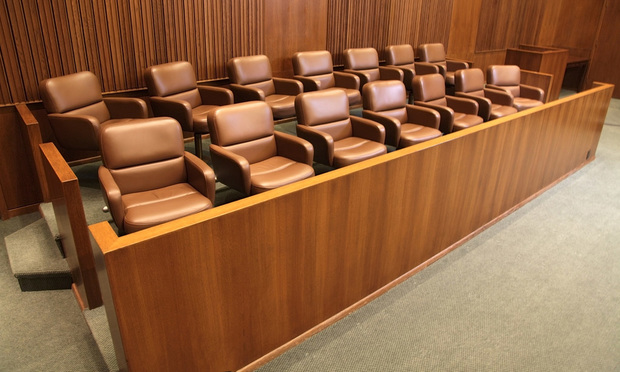Jury Returns $3.6M Medical Malpractice Verdict for Torn Urethra
The plaintiff, an engineer, suffered the tear to his urethral wall during a routine cystoscopy exam performed by a defendant urologist, after he'd gone to the doctor complaining of blood in his urine. He had one surgery aimed at correcting recurring problems and plans another.
March 19, 2019 at 06:53 PM
5 minute read
 Photo: Jason Doiy/ALM
Photo: Jason Doiy/ALM
A Brooklyn man who during a 2010 urological procedure suffered a tear to his urethral wall that continues to cause severe issues and requires additional surgery has won a nearly $3.6 million medical malpractice verdict at trial, according to his lawyers and court documents.
Kenneth Shook, represented by Kramer, Dillof, Livingston & Moore since filing his lawsuit in 2012, was awarded $2.64 million for future pain and suffering, and $950,000 for past pain and suffering, according to a verdict sheet filed in Brooklyn Supreme Court earlier this month.
The exact amount awarded will not be paid out, however, due to a settlement arrived at after the verdict. Shook and Dr. Marc Kaplan, a Manhattan urologist named as a defendant in the lawsuit, settled for an amount that cannot be disclosed, according to Shook's lawyers.
Shook, an engineer, suffered the tear to his urethral wall during a routine cystoscopy exam performed by Dr. Kaplan in 2010, according to court documents and two of Shook's Kramer Dillof attorneys, James Moore and John Cagney.
Shook had gone to Kaplan with complaints of blood in his urine, and the exam was intended to rule out certain causes for the bleeding, according to Moore. But a small sheath with a tiny camera on one end inserted into the urethra tore a wall, and in subsequent years Shook has suffered from recurring strictures—scar tissue buildup stemming from the tear—that has caused him urinary complaints, pain and other issues. It also had already led to one surgery in 2012. And Shook intends to have another surgery soon in the hopes that it will be successful and the strictures will stop recurring, his lawyers said.
On Feb. 22, an all-male, six-person jury delivered a verdict after a nearly month-long trial covering both liability and damages. Supreme Court Justice Karen Rothenberg presided. Kaplan was one of two physicians named as a defendant in Shook's case. The other was Manhattan-based neurologist Dr. Anthony Geraci, court documents show.
The jury, as detailed on the verdict sheet—which explained that for any specific finding listed, five of six jurors had to agree—found Kaplan liable for medical professional negligence and separately found that his negligence caused Shook's injuries.
The jury also found Geraci liable for malpractice for departing from acceptable standards of care. But it found that Geraci's negligence did not cause Shook's injuries, according to the verdict sheet. Therefore the damages awards do not pertain to Geraci. Shook had seen Geraci around 2010 or 2011, as Kaplan for months had failed to correctly diagnose the cause of his problems as coming from a stricture, according to Moore and Cagney. Kaplan had referred Shook to Geraci for examination, they said.
Gerard Marulli of Marulli, Lindenbaum & Tomaszewski in Manhattan represented Kaplan during the trial. He could not be reached for comment. It is unclear whether Kaplan intends to appeal any aspect of the trial or verdict.
Michael Kelton, a partner at Abrams, Fensterman, Fensterman, Eisman, Formato, Ferrara, Wolf & Carone in Manhattan, represented Geraci. He also could not be reached for comment on Tuesday.
The trial lawyering on Shook's behalf was handled by James Moore, a Kramer Dillof associate who was litigating the first civil trial in his career. A 2015 Fordham Law graduate, he'd spent nearly two years as an assistant district attorney in the Brooklyn DA's Office before joining Kramer Dillof, which he and Cagney called a highly regarded Manhattan boutique firm specializing in plaintiffs-side medical malpractice and negligence cases. Cagney is a partner at the firm and also helped work the case.
The trial, said Moore in a phone interview, featured testimony by Shook, as well as by the combined six expert witnesses called by the parties in the suit.
The defense for Kaplan, he said, focused on arguing that while Kaplan, a treating urologist, did cause some level of injury to Shook, the injury was within an acceptable risk for the cystoscopy procedure.
Kaplan's lawyer called an expert witness who testified to that, Moore said. But Moore argued that the injury suffered was, in fact, severe, traumatic and long-lasting. In his view, the defense would have needed to show that the injury that happened was very minor.
“We were able to show that there had been such a traumatic injury caused during the procedure that any doctor properly performing the procedure would have noticed it immediately and would have been able to take steps to have prevented a stricture from forming,” Moore said.
In addressing both keys to the trial and its nearly four-week length, he also noted that “there was no sure issue in the trial, because you were talking about treatment that occurred over the course of multiple months by both doctors.”
“You really had to go blow by blow, especially with the defendants [Dr. Kaplan and Dr. Geraci] when I had them on the witness stand, in order to flesh out for the jury what the negligence was,” Moore added.
When the verdict was finally delivered, after two days of jury deliberations, Shook, he said, “was pretty ecstatic.”
“It had been a no [settlement] offer case, so as we got into the end of the second day of jury deliberations, he was getting a little nervous,” Moore recalled. “It's been a long ordeal for him. I could tell he was quite ecstatic with the result.”
Shook, who Moore said used to live in Brooklyn but now is a Hoboken, New Jersey, resident, was able to keep working in Manhattan as an engineer, but has had continuing problems as strictures have come back. He hopes to have a successful corrective surgery in the near future, Moore said, and “hopefully will get back to where he was” in his life.
This content has been archived. It is available through our partners, LexisNexis® and Bloomberg Law.
To view this content, please continue to their sites.
Not a Lexis Subscriber?
Subscribe Now
Not a Bloomberg Law Subscriber?
Subscribe Now
NOT FOR REPRINT
© 2025 ALM Global, LLC, All Rights Reserved. Request academic re-use from www.copyright.com. All other uses, submit a request to [email protected]. For more information visit Asset & Logo Licensing.
You Might Like
View All
Health Care Data Breach Class Actions Saw December Surge in NY Courts


Big Tech and Internet Companies Slammed With Consumer Class Actions in December

Amid Growing Litigation Volume, Don't Expect UnitedHealthcare to Change Its Stripes After CEO's Killing
6 minute readTrending Stories
- 1Courts Grapple With The Corporate Transparency Act
- 2FTC Chair Lina Khan Sues John Deere Over 'Right to Repair,' Infuriates Successor
- 3‘Facebook’s Descent Into Toxic Masculinity’ Prompts Stanford Professor to Drop Meta as Client
- 4Pa. Superior Court: Sorority's Interview Notes Not Shielded From Discovery in Lawsuit Over Student's Death
- 5Kraken’s Chief Legal Officer Exits, Eyes Role in Trump Administration
Who Got The Work
J. Brugh Lower of Gibbons has entered an appearance for industrial equipment supplier Devco Corporation in a pending trademark infringement lawsuit. The suit, accusing the defendant of selling knock-off Graco products, was filed Dec. 18 in New Jersey District Court by Rivkin Radler on behalf of Graco Inc. and Graco Minnesota. The case, assigned to U.S. District Judge Zahid N. Quraishi, is 3:24-cv-11294, Graco Inc. et al v. Devco Corporation.
Who Got The Work
Rebecca Maller-Stein and Kent A. Yalowitz of Arnold & Porter Kaye Scholer have entered their appearances for Hanaco Venture Capital and its executives, Lior Prosor and David Frankel, in a pending securities lawsuit. The action, filed on Dec. 24 in New York Southern District Court by Zell, Aron & Co. on behalf of Goldeneye Advisors, accuses the defendants of negligently and fraudulently managing the plaintiff's $1 million investment. The case, assigned to U.S. District Judge Vernon S. Broderick, is 1:24-cv-09918, Goldeneye Advisors, LLC v. Hanaco Venture Capital, Ltd. et al.
Who Got The Work
Attorneys from A&O Shearman has stepped in as defense counsel for Toronto-Dominion Bank and other defendants in a pending securities class action. The suit, filed Dec. 11 in New York Southern District Court by Bleichmar Fonti & Auld, accuses the defendants of concealing the bank's 'pervasive' deficiencies in regards to its compliance with the Bank Secrecy Act and the quality of its anti-money laundering controls. The case, assigned to U.S. District Judge Arun Subramanian, is 1:24-cv-09445, Gonzalez v. The Toronto-Dominion Bank et al.
Who Got The Work
Crown Castle International, a Pennsylvania company providing shared communications infrastructure, has turned to Luke D. Wolf of Gordon Rees Scully Mansukhani to fend off a pending breach-of-contract lawsuit. The court action, filed Nov. 25 in Michigan Eastern District Court by Hooper Hathaway PC on behalf of The Town Residences LLC, accuses Crown Castle of failing to transfer approximately $30,000 in utility payments from T-Mobile in breach of a roof-top lease and assignment agreement. The case, assigned to U.S. District Judge Susan K. Declercq, is 2:24-cv-13131, The Town Residences LLC v. T-Mobile US, Inc. et al.
Who Got The Work
Wilfred P. Coronato and Daniel M. Schwartz of McCarter & English have stepped in as defense counsel to Electrolux Home Products Inc. in a pending product liability lawsuit. The court action, filed Nov. 26 in New York Eastern District Court by Poulos Lopiccolo PC and Nagel Rice LLP on behalf of David Stern, alleges that the defendant's refrigerators’ drawers and shelving repeatedly break and fall apart within months after purchase. The case, assigned to U.S. District Judge Joan M. Azrack, is 2:24-cv-08204, Stern v. Electrolux Home Products, Inc.
Featured Firms
Law Offices of Gary Martin Hays & Associates, P.C.
(470) 294-1674
Law Offices of Mark E. Salomone
(857) 444-6468
Smith & Hassler
(713) 739-1250






